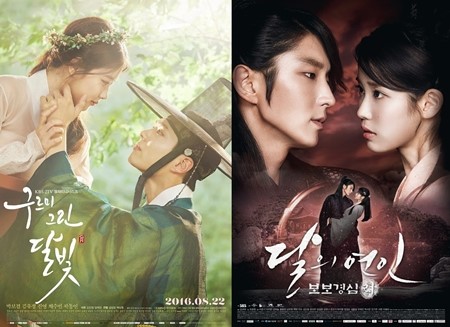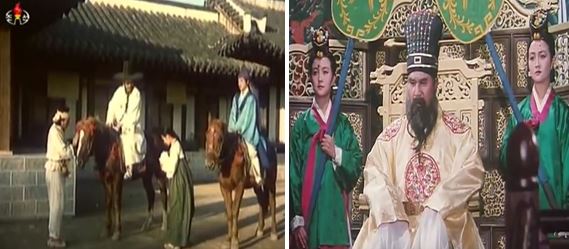 Two popular South Korean dramas: KBS2’s “Moonlight Drawn by Clouds” (left) and SBS’ “Moon Lovers: Scarlet Heart Ryeo” on the right. Image: Official promo poster screen grab |
Historical dramas are all the rage these days in South
Korea, with hits like SBS’s Six Flying Dragons, KBS1’s “Jang Yeong Sil,” KBS2’s “Moonlight Drawn by Clouds,” and MBC’s “The Flower in Prison,” all exemplifying the
staying power and popularity of the genre.
Historical dramas build off recorded history by adding
fictional characters and elements, using clever props and costuming to provide
viewers with a vivid insight into historical lifestyles. These dramas can be
further broken down into subcategories, including traditional, realistic, and
fusion.
A new subcategory has recently emerged, one that combines
elements of historical drama with fantasy. “Moon Lovers: Scarlet Heart Ryeo” is
a leading example, combining themes of reincarnation and time travel. With its
mysterious storylines and intriguing premise, the show is drawing large numbers
of viewers.
If we turn our glance towards historical dramas produced in
North Korea, we see some stark contrasts. North Korea’s Korean Central Television broadcasts
domestically-produced shows, but the number pales in comparison to the South.
Most North Korean films and television programs focus on the history of the Kim
family, the revolutionary period, and other aspects of regime propaganda. This
leaves little room creative intrigue.
North Korean historical dramas all begin with the same
opening text: “The people’s art is dedicated to fulfilling the directive of
widely spreading knowledge about the Great General’s accomplishments.” This is
particularly resonant because historical dramas are some of the only North
Korean productions that do not feature the Kims or glorify the Workers’ Party,
as the events take place before their time.
Defector testimony tells us that historical dramas were
occasionally broadcast in the past, but that they are getting harder and harder
to find on television. In the early 2000s, historical dramas were shown to help
emphasize the importance of history and the “people first” principle. However,
in the Kim Jong Un era, the emphasis has returned to regime idolization,
resulting in fewer productions of historical dramas that shine a light on other
figures.
On October 11, Daily NK met North Korean defector Kang Kyung Ae (pseudonym) who, when queried on the
changing nature of regime broadcasts, said, “Kim Il Sung and Kim
Jong Il’s reigns were much different. Despite hardship, most people had enough
to eat and the inter-Korean summit gave people hope for unification. During
that time, it was relatively easy to watch an historical drama on TV. However,
things began to change in the mid 1990s, when food security hit rock bottom.
From that time, and under Kim Jong Un’s reign, it’s become quite difficult to
find that type of programming.”
Although the availability of historical dramas has
decreased, the shows remain popular among the North Korean people. These
historical dramas are attractive because they focus on the lives of ordinary
characters more so than kings and bureaucrats. North Korean residents
appreciate this because most of the shows and movies they are used to have
strong political undertones and tend to ignore the struggles of everyday
people. The introduction of smuggled South Korean media into the North has also
found an eager audience, with many enthusiastic fans of South Korean historical
dramas.
Defector Lee Yong Il also weighed in, saying, “Dramas that portray the Japanese Invasion of Korea in 1592 and
the valiant defense led by Admiral Yi Sun Shin provided viewers with a sense of
justice and patriotism. Other dramas, such as ‘Im Kkeokjeong’ and ‘Hong Kil Dong,’ portray a people’s rebellion and the punishment of corrupt officials. They were
spectacularly popular programs.”
“In 2007, KBS and Korean Central TV collaborated to produce
a program called ‘Six Martyred Ministers.’ This was the first North Korean
production to portray the Joseon Dynasty period. It pioneered new storytelling
tropes in North Korea and remains influential to this day,” the source
continued.
Defector Park Kyung Chul (pseudonym) added, “Both North and South Korea produced
historical dramas about Hong Kil Dong, but I thought that the South Korean
version was much more fun to watch. South Korean dramas have a production
quality and imagination that is mesmerizing to North Korean viewers.”
 North Korean historical dramas: “Harang and General Jin” (left) and “Hong Kil Dong”(right). Image: KCTV screen grab. |

















